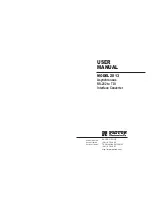
2
IM 77J01Q08-01E
8th Edition
MODEL AND SUFFIX CODES
Model
Suffix codes
Description
VJQ8
-0
x x -x x x
0
/x
Pulse to Analog Converter
(Multi-function)
-0
Always 0
Output
1
1 output
2
2 outputs
Power supply
6
100-240 V AC/DC
(*1)
7
15-30 V DC
(*2)
Transmitter power
supply
-1
12 V DC ±10%
-2
24 V DC ±10%
Output-1 signal
A
4 to 20 mA DC
B
2 to 10 mA DC
C
1 to 5 mA DC
D
0 to 20 mA DC
E
0 to 16 mA DC
F
0 to 10 mA DC
G
0 to 1 mA DC
1
0 to 10 mV DC
2
0 to 100 mV DC
3
0 to 1 V DC
4
0 to 10 V DC
5
0 to 5 V DC
6
1 to 5 V DC
7
−10 to +10 V DC
Z
Custom order (DC current/
voltage signal)
Output-2 signal
A
4 to 20 mA DC
6
1 to 5 V DC
P
Communication function
(RS-485)
T
Alarm output (2 relay
contacts)
N
No output-2
0
Always 0
Options
/SN
No socket (with socket if not
specified)
/R100
With 100 Ω shunt resistor
(*3)
/R220
With 220 Ω shunt resistor
(*3)
/R510
With 510 Ω shunt resistor
(*3)
/R1000
With 1000 Ω shunt resistor
(*3)
/R2200
With 2200 Ω shunt resistor
(*3)
/C0
Coating
(*4)
/FB
Fuse bypass
(*4)
*1
Operating range: 85 to 264 V AC/DC
*2
Operating range: 12 to 36 V DC
*3
Specify when current pulse input
*4
When option code /C0 or /FB is specified, the conformity to the safety
and EMC standards is excluded. CE marking is not applicable.
Note: An exclusive User’s Manual might be attached to the
products whose suffix codes or option codes contain the code
“Z” (made to customers’ specifications). Please read it along
with this manual.
1. MOUNTING METHOD
CAUTION
●
Plug/disconnect the main unit into/from the
socket vertically to the socket face. Otherwise the
terminals may bend and it may cause bad contact.
●
The converter shall not tilt 5 degrees or more in
either direction when installed.
●
When the converter is not connected to the socket,
it is necessary to protect the socket against ingress
of dust to the connector part.
●
Keep this product in a conductive bag when
plugged out, during transport or storage.
1.1 Wall Mounting
Loosen the main unit-fixing screw of the product and pull out the
main unit from the socket. Fix the socket on the wall with screws.
Next, insert the main unit into the socket and fasten the main unit
with the main unit-fixing screw.
29.5 or more
22±0.2
2-M4 or
2-ø4.5 or more
Mounting Dimensions
Unit: mm
59±0.3
Main unit-fixing screw
Socket
Main unit
Threaded hole for
fixing the main unit
Mounting screws
1.2 DIN Rail Mounting
Insert a DIN rail into the upper part of the DIN rail groove on the
rear of the socket, and then slide the slide lock at the lower part of
the socket upwards until the socket is fixed into position as shown
below
DIN rail
DIN rail
(Rear of socket)
Slide look
DIN rail
Fit into here
Push
1.3 Mounting Using
When using a multi-mounting base, see the User's Manual for
VJCE (VJ Mounting Base).
1.4 Using a Duct
When using a wiring duct, install the duct at least 30 mm away
from the top and bottom faces of the main unit.
2. INSTALLATION AND ENVIRONMENTAL
CONDITIONS
•
Avoid the following environments for installation locations:
Areas with vibrations, corrosive gases, dust, water, oil,
solvents, direct sunlight, radiation, a strong electric field,
and/or a strong magnetic field, direct radiant heat, wind,
temperature fluctuation.
•
If there is any risk of a surge being induced into the power
line and/or signal lines due to lightning or other factors, a
dedicated lightning arrester should be used as protection for
both the product and a field-installed device.
• Use indoors at an altitude of 2000 m or less.
•
Operating temperature/humidity range: −10 to 55°C (−10
to 45°C for side-by-side mounting*)/5 to 90%RH (no
condensation)
* If the previous model (style S3.xx earlier) is installed
together, the ambient temperature is 0 to 40°C.
•
Continuous vibration: (at 5 to 9 Hz) Half amplitude of 3 mm or
less (at 9 to 150 Hz) 9.8m/s
2
or less, 1 oct/min for 90 minutes
each in the three axis directions
•
Impact: 98 m/s
2
or less, 11 ms, 3 axes, 6 directions, 3 times
each
























